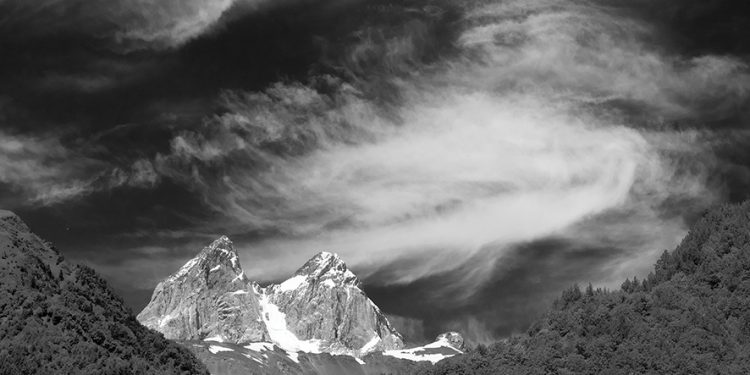In a landscape, there are a number of things which can change. Lighting angle and intensity, as the planet rotates about its light source, the sun; seasonal coloring of vegetation; presence or absence of snow; and clouds, and how they affect both the sky’s appearance and the directness or softness of that sunlight.
I’m processing more and more of my photography in black and white these last few years (though always from color originals). There are numerous ways to do this on a photo editing program such as Photoshop, and many of them also emulate what used to be done using film and accessories in the darkroom.
A selection of colored filters, for example, when placed over a color image converted to black and white, will change the contrast of colors’ tones relative to each other in grays. A yellow, orange or red filter will progressively darken skies from washed out light gray to dramatically darker. As the great American landscape photographer of the last century, Ansel Adams, wrote, in monochrome landscape images, we are not aiming for what was “actually there” (the world is colored, after all!), but what eye and memory imagine as the ideal. So, by all means, darken those skies!
Green or yellow filters will lighten foliage, if you are seeking contrast with a nice dark sky. And so on.
A few days ago I had to drive to Mestia for some supplies, and, as I always do, I took my camera along. The skies had been giving displays of high, wispy clouds all morning, and I hoped to find some drama in straight cloud shots and in skies along with mountains. I was not disappointed.
We can’t see Mt. Ushba directly from the house; the closest place to see its peak is about 10 minutes’ walk from us. I didn’t bother doing that, but just drove off towards Becho, from the approach to which you get the whole mountain’s southern side in about the same time anyway; and the odds were good based on what clouds I could see. A cloudless blue sky is boring; a plain gray one too. But in between are endless variations.

You drive around a hairpin corner… and there, dominating the scene above Becho village, is The Mountain. I took a few shots, and some more from the other end of another longer hairpin, appreciating the thing’s glorious solidity and the wispiness of the clouds.
By the time you reach Mestia, you have come nearly 90 degrees around Ushba, and it’s hardly recognizable as the same peak as from Becho. I should say peaks, though, because there are two of them, a meter apart in height, and from Mestia’s angle you see them side by side.
I have a favorite spot, recently discovered, from where Lenjeri meets Mestia, to park and walk 5 minutes or so and see Ushba dramatically emerge from the mountains in the foreground. So I went there, and still the clouds (which I had been shooting in isolation on the way) contrasted perfectly with the rocky peaks’ bulk. I could have gone on past Mestia to Mulakhi and the zig-zag pass between it and Ipari, but there were time constraints with the urgency of the shopping; so I forbore. What I had was enough to remind me that landscapes are new every day, hour and minute, and to be ready. Such is my task, and my privilege.
Blog by Tony Hanmer
Tony Hanmer has lived in Georgia since 1999, in Svaneti since 2007, and been a weekly writer and photographer for GT since early 2011. He runs the “Svaneti Renaissance” Facebook group, now with over 2000 members, at www.facebook.com/groups/SvanetiRenaissance/
He and his wife also run their own guest house in Etseri: www.facebook.com/hanmer.house.svaneti














